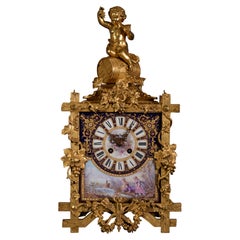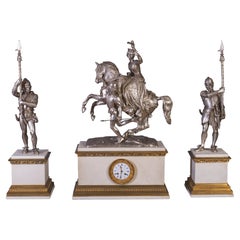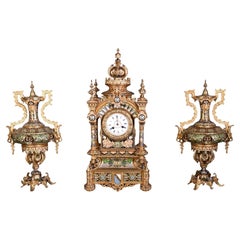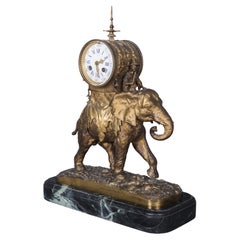Want more images or videos?
Request additional images or videos from the seller
1 of 19
Equestrian statue of William I and two candelabras with halberdiers
$66,230.25List Priceper set
About the Item
- Creator:Count Alfred Émilien O'Hara van Nieuwerkerke (Sculptor)
- Dimensions:Height: 33.08 in (84 cm)Width: 18.51 in (47 cm)Depth: 9.85 in (25 cm)
- Sold As:Set of 3
- Style:Romantic (Of the Period)
- Materials and Techniques:
- Place of Origin:
- Period:
- Date of Manufacture:1843
- Condition:
- Seller Location:SAINT-OUEN-SUR-SEINE, FR
- Reference Number:Seller: 10682/203861stDibs: LU7662232562012
About the Seller
No Reviews Yet
Recognized Seller
These prestigious sellers are industry leaders and represent the highest echelon for item quality and design.
1stDibs seller since 2022
Typical response time: 10 hours
Authenticity Guarantee
In the unlikely event there’s an issue with an item’s authenticity, contact us within 1 year for a full refund. DetailsMoney-Back Guarantee
If your item is not as described, is damaged in transit, or does not arrive, contact us within 7 days for a full refund. Details24-Hour Cancellation
You have a 24-hour grace period in which to reconsider your purchase, with no questions asked.Vetted Professional Sellers
Our world-class sellers must adhere to strict standards for service and quality, maintaining the integrity of our listings.Price-Match Guarantee
If you find that a seller listed the same item for a lower price elsewhere, we’ll match it.Trusted Global Delivery
Our best-in-class carrier network provides specialized shipping options worldwide, including custom delivery.You May Also Like
Mantel Set with Clock and Two Candelabras, 19th Century.
Located in Saint-Ouen, FR
Garniture de cheminée en bronze doré et marbre, XIXème siècle, époque Napoléon III.
Pendule: H: 36cm, L: 15cm, P: 18cm
Candélabres: H: 26cm, L: 17cm, P: ...
Category
Antique 19th Century French Napoleon III Mantel Clocks
Materials
Marble, Bronze
Egyptian Revival Marble Clock with Two Candelabra Granitures
Located in Los Angeles, CA
This renowned clock maker, Bailey & Company out of Philadelphia are responsible for this stunning and rare set.
Clock: 19.5" H x 11" W x 6"D
Candelabras: 13.5" H x 10.5 W x 4" D
Category
Antique 1870s Unknown Egyptian Revival Mantel Clocks
Materials
Marble, Bronze
Italian Ornate Mantel Clock with Two Figural Cherub Candelabras - Garniture Set
By Hermle
Located in Chicago, IL
Vintage Italian Roman Style Ornate Mantel Clock with Two Figural Cherub Candelabras - Garniture Set
The Vintage Italian Roman Style Ornate Mantel ...
Category
Mid-20th Century Italian Classical Roman Mantel Clocks
Materials
Brass
$3,328 / set
H 15 in W 7.5 in D 3 in
Antique Gilt Bronze Triptych - Fireplace Clock with Pair of Candelabra
By Mice di rugiano domenico e c. s.n.c.
Located in Cantù, IT
Extraordinary decorative triptych consisting of a mantel clock and a pair of five-armed candelabra, made of finely chiseled gilt bronze. This elegant ensemble, distinctly Rococo in s...
Category
Antique 19th Century Italian Rococo Mantel Clocks
Materials
Bronze
$3,010
H 0.4 in W 0.4 in D 0.4 in
Pair of Putti Bronze Candelabras
Located in Los Angeles, CA
Pair of bronze candelabras with brown patina puttis.
Category
Antique 1890s French Mantel Clocks
Materials
Bronze
Quality antique Victorian clock garniture with a pair of candelabras
Located in Ipswich, GB
Quality antique Victorian clock garniture with a pair of candelabras standing on onyx bases with ornate brass mounts having a cylinder clock w...
Category
Antique Early 19th Century Victorian Table Clocks and Desk Clocks
Materials
Onyx, Brass
$2,067 / set
H 16.54 in W 8.86 in D 4.34 in
Tiffany & Co Champlevé and Bronze Clock Set with Candelabras
By Tiffany & Co.
Located in New York, NY
Tiffany & Co Blue Champlevé and Bronze Clock Set with matching Champlevé Candelabras
Retailed by Tiffany & Co , New York.
Stamped Tiffany & co on the internal clock mechanism
Dat...
Category
Antique Late 19th Century American Mantel Clocks
Materials
Enamel, Bronze
19th Century Onyx and Bronze Clock with William Shakespeare
Located in Hoddesdon, GB
A William Shakespeare Gothic revival mantle clock, dating back to the mid-19th century, superb quality and is made from onyx and gilt bronze. The clock showcases reeded column suppor...
Category
Antique Mid-19th Century French Gothic Revival Mantel Clocks
Materials
Onyx, Bronze
Triptych of purple candelabra with mechanical clock in 1990s baroque style
By Mice di rugiano domenico e c. s.n.c.
Located in Cantù, IT
Triptych of purple candelabra with mechanical clock in baroque style 1990s New
Category
20th Century Italian Baroque Table Clocks and Desk Clocks
Materials
Bronze
$3,492
H 0.4 in W 0.4 in D 0.4 in
Louis XVI Style Bronze and Marble Garniture Set with Clock & Candelabras
Located in Astoria, NY
Louis XVI Style Patinated and Gilt Bronze and White Marble Three Piece Clock Set, late 19th century, comprising a globe clock, with strike on bell timepiece movement, supported by th...
Category
Antique Late 19th Century European Neoclassical Mantel Clocks
Materials
Marble, Metal, Bronze, Ormolu
$4,600 / set
H 16.5 in W 21 in D 21 in
More From This Seller
View AllNapoleon III Style Clock Made Out of Porcelain and Gilded Bronze
Located in SAINT-OUEN-SUR-SEINE, FR
This beautiful clock was made out of porcelain and gilded bronze during Napoleon III period. The porcelain dial indicates the hours with Roman numerals. It is decorated with gilded r...
Category
Antique 19th Century French Napoleon III Mantel Clocks
Materials
Bronze
Set clock with Marie de Bourgogne going falcon hunting
By Jean-Auguste Barre
Located in SAINT-OUEN-SUR-SEINE, FR
This important silvered bronze, gilded bronze and white Statuary marble clock set was probably made around 1840-1844. The central group is depicting Mary of Burgundy on a falcon hunt...
Category
Antique 19th Century French Renaissance Revival Mantel Clocks
Materials
Marble, Bronze
Persian-style double-sided clock and garnitures, Charles Stanislas MATIFAT
By Charles Matifat
Located in SAINT-OUEN-SUR-SEINE, FR
Charles Stanislas Matifat is the creator of this ensemble consisting of a double-sided enameled bronze clock and a matching pair of large garnitures. Dated 1851 and bearing his signa...
Category
Antique 19th Century European Islamic Table Clocks and Desk Clocks
Materials
Bronze, Enamel
Christophe FRATIN (1801-1864) rare Asian elephant clock, in gilded and patinated
By Christophe Fratin
Located in SAINT-OUEN-SUR-SEINE, FR
France, circa 1870
Gilded and patinated bronze, modern marble base.
Signed « Fratin » on the bronze base
This beautiful elephant clock was made in the 19th century by the Animalier ...
Category
Antique 1870s French Napoleon III Table Clocks and Desk Clocks
Materials
Bronze
Egyptian Revival Mantel Clock, 19th Century
By Georges Emile Henri Servant
Located in SAINT-OUEN-SUR-SEINE, FR
Mantel clock in patinated and gilt bronze, with red and black marble, in the Egyptian Revival style of the 19th century.
The composition features a standing female Egyptian figure h...
Category
Antique 19th Century French Egyptian Revival Mantel Clocks
Materials
Marble, Bronze
Louis XV ormolu clock by Gille l'Ainé
Located in SAINT-OUEN-SUR-SEINE, FR
Beautiful little antique clock in the Louis XV style made by the clockmaker Gille l'Ainé in the 19th century. The dial is signed "Gille l'Ainé, à Paris". The curved forms, embellishe...
Category
Antique 19th Century French Louis XV Mantel Clocks
Materials
Bronze
Recently Viewed
View AllMore Ways To Browse
Mantel Candelabra
Bronze Statue On Marble Pedestal
Plaster Bust Sculpture On Marble
French Clock And Candelabra
Statue King
19th Century Italian Marble Clocks
Antique Hara
Mantel Clock With Candelabra
Statue Clock
Bronze Equestrian Statue
Antique Statue Clocks
Antique French Statue Clocks
Bronzes Of Equestrian Napoleon
Art Deco Marble Clocks
Unusual Antique Clocks
Champleve Clocks
Gilded French Clock
Art Deco French Mantel Clocks



